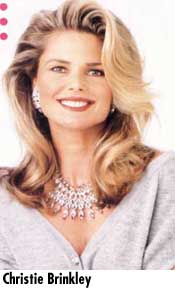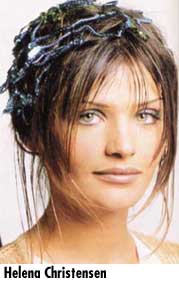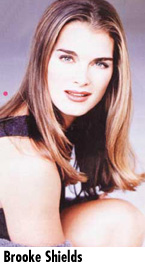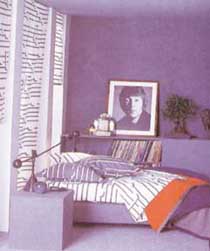 |
 8th March 1998 |
Front Page| |
|||||||||||||||||
|
Chemical Hair StraightenersChemical hair straighteners are the only products that will produce long-lasting straightening of visible hair. The principle used is just the reverse of that of permanent waving, in that the hair is straightened rather than curled after the chemical bonds have been disrupted. However, stronger chemicals are usually required for straightening than for waving. The alkaline straighteners contain the strongly caustic chemical sodium hydroxide. The sodium hydroxide causes the hair to swell and induces breakage and alteration of the chemical bonds in the hair fibres. This action is very rapid, and the fibres relax quickly under the tension of combing. The hair is then rinsed with water to stop the chemical action. Because of the rapid chemical action of these products, they must be left on the hair for no longer than 5 to 10 minutes; otherwise the hair may be seriously damaged. The scalp and skin may suffer first - to third-degree chemical burns from contact with the sodium hydroxide, so the scalp and surrounding skin should be covered with a protective cream. Follow-up care is elaborate and includes successive applications of moisturizers, curl activators, and oil sheen that saturate the hair and scalp. A plastic cap is worn to bed each night. Hair that has been damaged by prior chemical treatments such as bleaching should not be subjected to straightening. Also, some manufacturers advise against using hair colours that require peroxide on chemically straightened hair. While chemical straighteners straighten the visible hair, it's necessary to straighten the new hair growth every few months. Care must be taken not to double-process hair that has already been straightened, or severe damage and hair breakage may occur. This is difficult to avoid because of the combing technique that is an integral part of straightening.
|
|||||||||||||||||||
Decorating with Dark ShadesDon't interrupt a dark wall with contrasting doors or mouldings. Paint them to match the colour of the wall and keep to shades of equal depth for carpets, flooring and fitted furniture to create an impression of space. Artificial light is especially important in dark rooms. Choose fittings which cast pools of light to illuminate specific areas because general lighting will only make the room seem gloomy. Consider using lights with tungsten halogen lamps which cast a dramatically bright light. |
Beauty secrets
The world's most beautiful women still look their best when the heat's on. Here, Bonnie Siegler asks eight supermodels to give you their top beauty tips to stay fresh.
 |
Niki Taylor.
Lips have even less natural sun protection than the rest of the face, so they can burn easily, cautions Niki. "Most people don't realise this and they neglect their lips. If you're not careful, they can become dry and chapped." Niki says that whenever she hits the beach, she slicks on lip balm. "Applying it every few hours, as you would a sunscreen, protects my lips." |
 |
Linda Evangelista
Linda keeps her cleansing routine simple and gentle when the heat is on."l wash my face with a translucent cleansing bar and then use a natural citrus-based and alcohol-free toner," she says. "And, of course, I always use a moisturiser with a sunscreen." Linda also thinks it is important to keep your lips moist and protected through summer by using a good lip balm. |
 |
Christie Brinkley
Sun, sand and surf can make your hair dry, dull and unmanageable."l grew up in Malibu [US]:' says the supermodel mother-of-two."l was a surfer, so I know the elements can take a toll on your hair." Christie advises using a leave-in conditioner or silicon glosser with sunscreen when you're in the sun or swimming, to seal the hair and protect it. To boost her hair's shine, she douses it with camomile tea before sitting in the sun. It will bring out your hair's natural highlights." Christie also deep-conditions her hair weekly, rubbing a hot oil pack into the ends. |
 |
Claudia Schiffer
"Most people are careful to slather on sunblock every time they sit by the pool, but how about all the other times they go out during the summer?" asks Claudia. She says you should apply a sunscreen every time you leave your house - even if you're only going to pick up the children or go to the supermarket. Fortunately, many foundations and concealers now come with built-in sunscreens. Why does Claudia think sunscreen is so important? She says it's because it doesn't take much to damage your skin. Make sunscreen part of your daily summer beauty routine ,' says Claudia. "It literally can save your skin." |
 |
Cindy Crawford
Cindy has a unique alternative to using moisturising creams when the sun's heat dries your skin."l mix very low-fat milk and water in a spritzer bottle,' she says. "When I'm exercising outdoors or feel my skin becoming dry, I spray on this mixture, taking off the excess with a tissue. It keeps my complexion soft and moisturised. Cindy also sprays this mixture over her sunscreen and foundation. "It's an inexpensive way to save your skin. |
 |
Helena Christensen
"Heat enhances the intensity of your perfume, which is all the more reason to try a new sexy scent for summer," says Helena."Fragrance is the one thing I can never stop buying. I probably have about 40 or 50 different ones. I alternate, depending on the mood I'm in". Helena's favourite summer scents are Chloe and Opium, "They are quite old fashioned, and I love putting them on. To help her fragrance last, Helena advises that you layer it. "Sometimes I'll start with a perfumed body lotion, then powder myself from top to toe." Aromatic oils are another good choice for summer as the scent lasts all day. "I rub some on the inside of my wrists or put some in my hair," explains Helena. |
 |
Rachel Hunter
Perspiration and certain sunscreens can make your complexion more vulnerable to breakouts. So the New Zealand-born model has her own simple summer cleansing routine. "I just use a milky cleanser and rinse several times with water, making sure I leave behind no residue," explains Rachel. Then she uses a light moisturiser with sunscreen during the day to prevent dryness. But she says that even supermodels have to battle the occasional blemish. "If I have a pimple, I dot toothpaste on it. It's gentle, not too drying and it really works." |
 |
Brooke Shields
During the summer, Brooke loves to exercise outdoors. "I play tennis, bike ride and swim," says the star of the Nine Network's Suddenly Susan. Perspiring can deplete your body of the fluids it needs to keep skin looking healthy, so Brooke has her own beauty booster. "In summer, I drink lots of spring water every day", she explains. "It quenches my thirst, takes away my appetite and makes my skin smoother. My complexion looks great." To reap the benefits of water, Brooke says she drinks at least eight glasses a day - more if she's working out. "Water moisturises from the inside out." |
More Mirror Magazine * Junior Times
![]()
Front Page| News/Comment| Editorial/Opinion| Business| Plus |Sports
Please send your comments and suggestions on this web site to The Sunday Times or to Information Laboratories (Pvt.) Ltd.

 to
charcoal grey, which is a strong favourite for carpets and furnishings.
In theory, grey is the only true neutral as it contains only black and
white, but in decorating you'll find shades which have a definite tinge
of pink, green, blue or beige. Grey works well with yellow and red, but
for a subtler look team it with honey or blue, or opt for a sophisticated
scheme of grey, buttermilk and beige.
to
charcoal grey, which is a strong favourite for carpets and furnishings.
In theory, grey is the only true neutral as it contains only black and
white, but in decorating you'll find shades which have a definite tinge
of pink, green, blue or beige. Grey works well with yellow and red, but
for a subtler look team it with honey or blue, or opt for a sophisticated
scheme of grey, buttermilk and beige.
